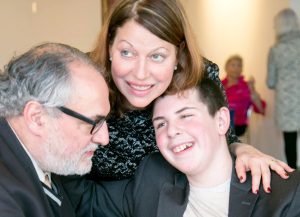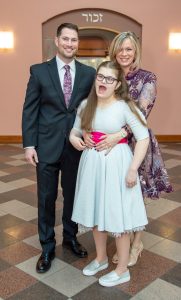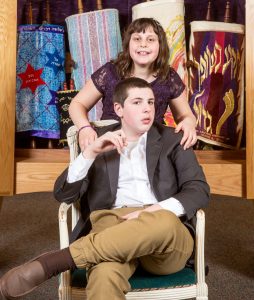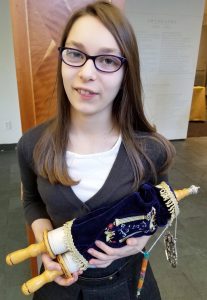Teach a child according to their way (Proverbs 22:6).
When you think of B-Mitzvah, what do you picture? Do you envision a young person standing on a synagogue’s bimah poised to chant from the Torah? Do you imagine a young person who will sing prayers and teach the meaning of a Torah portion? Is the sanctuary filled with family, friends, and worshippers?
 What happens when the young person doesn’t stand (maybe they use a wheelchair or have some other physical limitation)? What happens if they are not able to sing, to write, or deliver a d’var Torah, or if they are non-verbal? What is the B-Mitzvah experience when a young person has an intellectual, physical, or emotional disability?
What happens when the young person doesn’t stand (maybe they use a wheelchair or have some other physical limitation)? What happens if they are not able to sing, to write, or deliver a d’var Torah, or if they are non-verbal? What is the B-Mitzvah experience when a young person has an intellectual, physical, or emotional disability?
A B-Mitzvah experience for a young person with a disability is not less than any other; it will, however, require more thought, intention, and effort to create an experience that is meaningful and fulfilling.
We present the following steps you can follow as you imagine what is possible for every B-Mitzvah young person. Please keep in mind that these are guidelines — each community, each family, and each young person will have different needs, goals, and abilities.
1. Understand your community’s B-Mitzvah goals, process, and expectations.
B-Mitzvah is a significant coming-of-age ritual that can guide young people in their growing connection to Judaism, foster a stronger personal identity, deepen their commitment to their synagogue (if they belong to one), and develop skills that will carry them into their young adult and adult lives.
When the goals and expectations of the synagogue’s B-Mitzvah process are clear, we can accommodate to meet the unique needs of individual young people without concern that we are compromising the system as a whole.
 In many communities, this ritual is steeped in tradition and precedent. A synagogue’s B-Mitzvah process is typically designed to establish a sense of fairness among member families. Sometimes efforts by synagogue professionals — rabbis, cantors, B-Mitzvah coordinators, and educators — to ensure every B-Mitzvah process unfolds in exactly the same way reflects a lack of understanding of the true definition of fairness.
In many communities, this ritual is steeped in tradition and precedent. A synagogue’s B-Mitzvah process is typically designed to establish a sense of fairness among member families. Sometimes efforts by synagogue professionals — rabbis, cantors, B-Mitzvah coordinators, and educators — to ensure every B-Mitzvah process unfolds in exactly the same way reflects a lack of understanding of the true definition of fairness.
Fairness means that each of us has gets what we need to be successful, and that might mean something different for each preteen.
![]() Click HERE to read “Fair Isn’t Equal.”
Click HERE to read “Fair Isn’t Equal.”
Rabbi Mara Nathan, in a 2015 Kveller article, writes, “As a rabbi I have worked with many hundreds of bar and bat mitzvah students. No two children are the same and yet, I am sure that other Jewish professionals in congregational life would agree we tend to develop systems, expectations, and biases about the 12 and 13-year-olds that walk into our offices. How easy it is to forget the potential that these moments of meeting contain. But…when I remember that each child comes with different talents, abilities, and interests, I am able to help guide them toward a more meaningful and successful journey. Read more
2. Engage in open and honest dialogue with the family and other stakeholders.
Approach the B-Mitzvah process with an open mind, an open heart, respect, and a willingness to be flexible. Bring all of the key stakeholders — clergy, parents, grandparents, B-Mitzvah teen, tutor, and anyone else who will be directly involved — together to engage in a discussion about the process. Dialogue that is rooted in mutual respect allows for honest conversations where you can discuss both what is and is not reasonable or appropriate.
 “Cooperation…is essential to the development of a beautiful and meaningful ceremony that recognizes the person with a disability as a member of the Jewish community and is an affirmation of Jewish life that transcends all the usual boundaries…Open, honest dialogue can prevent misunderstandings and facilitate the process.” Read more
“Cooperation…is essential to the development of a beautiful and meaningful ceremony that recognizes the person with a disability as a member of the Jewish community and is an affirmation of Jewish life that transcends all the usual boundaries…Open, honest dialogue can prevent misunderstandings and facilitate the process.” Read more
To facilitate this session, a starting point can be to have everyone at the table answer the following question: What is your dream for this B-Mitzvah experience? The answers will help surface areas the various constituents are in agreement and where they are not.
In addition, consider asking the teen these questions to more clearly understand their point of view and their needs:
- What do you love about being Jewish?
- What are you afraid of or nervous about that I/we/this community can help you to overcome?
- How can each of us best support you?
3. Think creatively about how the teen will mark the experience.
This is the moment to dream. Use what you have learned from the dialogue in step 2 and together, with a willingness to experiment and try something that feels new, different, or even unusual, craft an experience that is both realistic and meaningful. It is essential to move from “this is how we have always done it” to embracing what is possible. And remember, what works for one young person will not necessarily work for another. The suggestions below are meant to offer inspiration for what is possible.
Ideas from other communities:
“To shape the service to his interests and needs, Yair (named changed for privacy) accompanied the rabbi on the piano during much of the morning service. Yair even wrote a new song for his Bar Mitzvah: a jazzy composition inspired by the words of Yotzeir Or (Creator of Light). Read more
“Diagnosed with autism, sensory processing disorder and apraxia of speech, Asher is largely nonverbal. His body often twitches and shakes and needs to be calmed by touch with a soft brush. But through a Tap to Speak computer program, he learned to tap on each Hebrew word on his iPad, activating a voice recording and creating a flowing rendition of the prayer.” Read more
 “George does not yet write; he primarily communicates to us by choosing icons with words and pictures on a communicative app on his iPad…George’s Torah portion was Beshalach, which includes the parting of the seas, a story that he knows very well from Passover. George loves color and since he was a toddler, has taken markers and paint and made beautiful collages of color. Our friend…made a sketch of the parting of the seas. I sat down with George and [the] sketch and gave him blue and green art materials. What George created is so beautiful. It hung in the sanctuary through the service and Rabbi Michelle used it during an interactive D’var Torah.” Read more
“George does not yet write; he primarily communicates to us by choosing icons with words and pictures on a communicative app on his iPad…George’s Torah portion was Beshalach, which includes the parting of the seas, a story that he knows very well from Passover. George loves color and since he was a toddler, has taken markers and paint and made beautiful collages of color. Our friend…made a sketch of the parting of the seas. I sat down with George and [the] sketch and gave him blue and green art materials. What George created is so beautiful. It hung in the sanctuary through the service and Rabbi Michelle used it during an interactive D’var Torah.” Read more
Jewish Grandparents Network conducted a teen focus group to shape their work around B-Mitzvah. Dylan, a teen participant, shares, “My bat mitzvah was a very special experience for me. With my dyslexia I had a hard time learning Hebrew. My mom made a plan for me to learn. She had people sign up to teach me important lessons they thought I should know. My uncle taught me about Emma Lazarus, a rabbi taught me about parts of the Torah, and we had a family friend who is a Jewish educator help me prepare and write my d’var Torah.
My bat mitzvah was a very meaningful experience for me because I got to feel more connected to my religion. My bat mitzvah was one year to the day that my grandfather passed away so I found ways to still connect with him. For example, the day after the ceremony, we had Waffle House come to our house because it was my grandfather’s favorite place to eat.”
4. Find partners in other communities.
 B-Mitzvah is a journey that the family travels in relationship with others. Seek out inspiration from other successful B-Mitzvah experiences, connect with colleagues who have done or are doing this work, and reach out to secular professionals who may be able to support you in this process.
B-Mitzvah is a journey that the family travels in relationship with others. Seek out inspiration from other successful B-Mitzvah experiences, connect with colleagues who have done or are doing this work, and reach out to secular professionals who may be able to support you in this process.
Gabrielle Kaplan-Mayer writes of her son George’s bar mitzvah: “In planning for George’s Bar mitzvah…We knew that it would take some creative planning to make the idea of celebrating George’s soul, rather than expecting any kind of performance of his skills, to be the focus of George’s Bar mitzvah. Fortunately, we had two insightful, passionate and compassionate [clergy] partners.” Read more
5. Be flexible and supportive on the day itself.
The steps above can lead you to a plan that is innovative and forward-thinking while also being realistic and practical. Yet, no matter how much we plan, we also need to be prepared for the unexpected. Approach the day of the B-Mitzvah with positivity and flexibility.
Some ideas to show support on the day of the B-Mitzvah:
- Have a plan for gently prompting should the B-Mitzvah forget their place. For example, if the teen is comfortable being touched, place a hand on the B-Mitzvah’s arm or make eye contact.
- Have a clergy member, a trusted teacher or tutor, parent or grandparent sit close to the B-Mitzvah for support throughout the experience especially if they are up on the bimah.
- Consider building a break into the experience for the B-Mitzvah where they might go outside for fresh air or a drink of water.

- Model from the bimah standing, stretching, or moving in an appropriate way to demonstrate to the congregation that this need not be a rigid, passive experience.
- Bring the community into the experience by offering an interactive d’var Torah, incorporating movement such as waving arms in the air or teaching the congregation something they can do with the B-Mitzvah teen. For example, if the B-Mitzvah is deaf, the congregation might learn to sign the Sh’ma.
Above all, keep talking to the family and stakeholders from the beginning of the process all the way through the B-Mitzvah day so that everyone can share their voice and be a part of this joyous experience.
Other Resources:
Jewish Learning Venture
Gateways: Access to Jewish Education
Matan
With gratitude to Gabrielle Kaplan-Mayer, Dylan Dickson, and Tali Cohen Carrus and Rebecca Redner of Gateways.
Lisa Friedman is a widely recognized expert in Jewish disability inclusion and has been a consultant for congregations, schools, camps, and other organizations for over twenty years. She also currently serves as Director of Education at a Reform congregation in Central New Jersey.
Photographic Credits
Banner and adult with teen behind screen by Stacy Rosenthal
Teen with yad pointing to Torah courtesy of Temple Beth-El in Hillsborough, NJ
Two adults and teen close up and two children in front of open Ark by Tracey Wood
Two adults and teen on checkered floor and teen holding mini-Torah courtesy of Gateways: Access to Jewish Education

